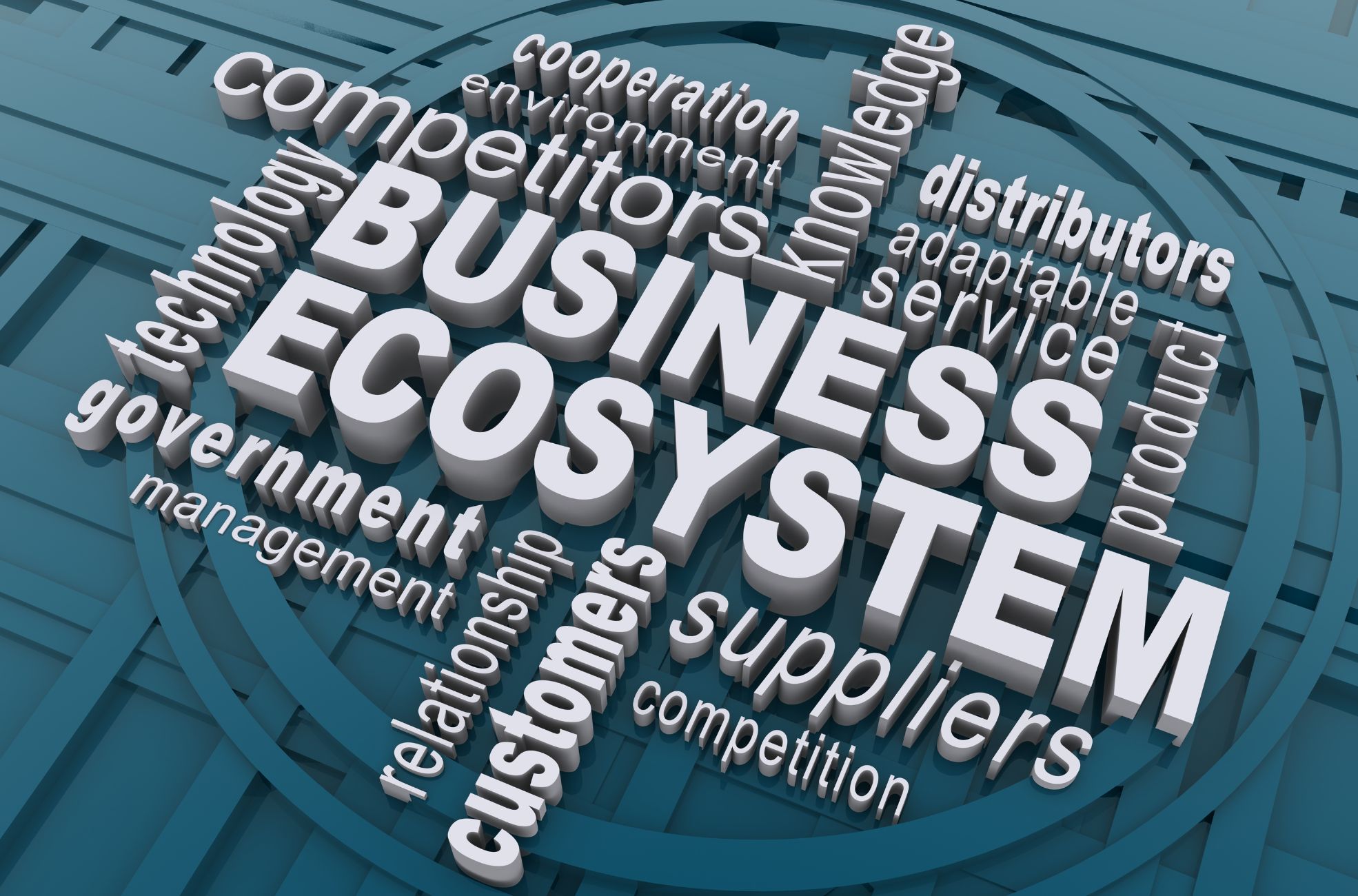Understanding a business environment is fundamental to navigating the complex web of factors influencing a company’s performance. The business environment definition is the amalgamation of tangible and intangible elements that shape the terrain in which businesses operate, grow, and evolve. From fluctuating economic conditions to ever-changing technological advancements, the business environment is a dynamic ecosystem that requires astute analysis and agile adaptation.
We look into the myriad components of this environment, exploring how internal and external influences intertwine to affect organisational strategies, operations, and, ultimately, success. As businesses strive to thrive amid a landscape of constant change, comprehending the breadth and depth of the business environment is critical in fostering resilience and seizing opportunities for sustained growth.
What is The Business Environment
The business environment encompasses all the internal and external factors influencing a company’s operations and success. These factors range from customer expectations and government interventions to the competitive landscape, legal regulations, and the economic climate. The business environment is important. It’s a complex and dynamic system that continuously interacts with the entities operating within it.
Importance of the Business Environment
Knowing the business environment helps you shape the strategies and decisions businesses need to thrive. It outlines the opportunities your business can seize and the threats you must watch out for. When you’re familiar with this concept, you can tailor your business’s operations more to meet external demands and trends, ensuring you stay relevant and competitive.
Key Elements of the Business Environment
The business environment is multifaceted, comprising various elements that influence business activities directly or indirectly. These elements include:
- The political climate, defined by government policies and political stability, can significantly affect business operations through regulations and laws.
- The economic environment, shaped by factors such as interest rates, inflation, consumer income, and economic policies, influences the economic system within which businesses operate.
- Social factors, including demographics, cultural trends, and lifestyles, impact consumer behaviour and demand for products and services.
- Technological advancements drive changes in production methods and can lead to innovation and improved product quality.
- Legal factors, encompassing the laws and regulations that govern business conduct, ensure that businesses operate within the confines of the law.
- Environmental considerations are becoming increasingly important as businesses are urged to adopt sustainable practices.
- The international environment, where global companies operate, adds another layer of complexity with its own set of economic, cultural, and legal challenges.
The Dynamic Nature of Business Environments
Business environments are characterised by rapid and continuous change. Various factors can drive this dynamism, including technological developments and breakthroughs, shifts in consumer preferences, demographic changes, and the emergence of new market players. Such changes can create uncertainty but also present opportunities for businesses to innovate and adapt.
The macro-environment, which affects all businesses regardless of industry, includes political, economic, social, and technological factors. These can be analysed using tools like PEST analysis. These macro-environmental factors affect and are beyond the control of any single business, yet they must be monitored and responded to for a business to remain competitive.
Businesses adept at managing change can create an environment that encourages innovation and agility. By embracing change, you can enhance efficiency, keep up with industry trends, and drive growth. However, successful adaptation requires clear organisational communication, robust management support, human resources, and a commitment to investing in the necessary transformations to business strategy, operations, and culture.

External Business Environment
Analysing the Macro-Environment
The macro-environment includes national economic indicators and overarching monetary and fiscal policies that delineate the context for business operations and strategic choices regarding investment, borrowing, and pricing.
A nation’s GDP is a primary indicator of its economic vitality and potential for business expansion. Inflation affects purchasing power and may necessitate adjustments in a company’s pricing strategies. Employment statistics provide insights into the labour market, influencing consumer confidence and expenditure, which in turn affects business revenues.
Particularly for businesses in cyclical industries, monitoring these macroeconomic conditions is crucial as they can profoundly influence the demand for products or services. Sectors reliant on consumer credit are especially sensitive to changes in interest rates, which can impact consumer spending and borrowing costs. Awareness of the macro-environment enables businesses to navigate economic fluctuations and modify their approaches accordingly.
The Micro-Environment
The micro-environment focuses on immediate factors that directly affect a company’s daily operations. It involves interactions with suppliers, distributors, customers, and competitors, which are specific to the company and crucial for achieving its goals.
Unlike the macro-environment, the micro is a business environment that is more within a company’s control and necessitates robust relationships with stakeholders. Suppliers affect a company’s production capacity, while customers are central to its revenue generation. Competitors dictate market positioning and influence pricing strategies. Analysing the micro-environment is essential for identifying growth opportunities and recognising potential risks.
Impact of Political and Legal Factors
Political and legal segments can profoundly influence business practices. Shifts in trade policy, such as the introduction of new tariffs, can affect cost structures for companies dependent on imports, compelling them to seek alternative suppliers or adjust their prices.
It is vital for companies to stay informed about political and legal changes to ensure compliance and maintain a competitive edge. This includes understanding the effects of government fiscal policies and the consequences of monetary policy decisions by central banks.
Economic Influences on Business
Various elements of the economic and social environment also influence consumer behaviour, such as disposable income and general spending patterns, which in turn affect consumers’ purchasing power and the demand for a company’s offerings.
Monitoring economic indicators is important for predicting shifts in consumer behaviour. An increase in disposable income usually results in heightened consumer expenditure, potentially elevating business sales. On the other hand, elevated unemployment can dampen consumer spending and demand for non-essential items, necessitating strategic adjustments for businesses.
Social and Cultural Considerations
Demographic changes can create new market opportunities or modify the demand for specific products. Companies need to be flexible and adjust their marketing strategies and product lines to these demographic trends.
Cultural aspects of society, encompassing societal norms, values, and behaviours, also play a role in consumer decision-making. Companies must grasp and honour these cultural distinctions to ensure their offerings and promotional content resonate with their intended audience. Moreover, environmental concerns and the increasing focus on sustainability are influencing consumer preferences, leading businesses to evaluate the ecological impact of their operations and product life cycles.

Internal Business Environment
Company Culture and Ethics
Your company’s ‘ethical personality’ is a blend of formal and informal components that promote ethical choices and conduct. Leadership plays a pivotal role in shaping this culture, not only through established ethics programs but also by exemplifying ethical behaviour. A robust ethical culture enhances job satisfaction, employee loyalty, and innovation, potentially increasing the organisation’s market value.
It is crucial to recruit individuals who align with these ethical standards and nurture a genuine culture of ethical conduct beyond mere compliance.
Organisational Structure and Resources
The organisational structure underpins your company’s operations. Considerations such as the company’s size, life cycle, objectives, and strategic positioning are crucial when crafting this structure. The structure is composed of elements like work specialisation, departmentation, chain of command, span of control, and the level of centralisation or formalisation.
Each component is designed to optimise processes and define roles. Depending on the company’s requirements, structures can range from hierarchical to flat and from functional to matrix or network-based. The flexibility of the organisational design is vital, as it may need to evolve with market changes.
A well-crafted structure promotes effective communication and workflow, ensuring that each team member contributes to the company’s goals.
Internal Stakeholders and Their Influence
Internal stakeholders, including employees, managers, and shareholders, significantly shape the company’s dynamics. Their roles, interests, and interactions influence the internal and external environment. The workforce is particularly influential, as their skills, attitudes, and interactions can greatly affect outcomes.
While internal politics and conflicts can be detrimental, a cooperative and supportive business environment can drive the company forward. The way internal stakeholders engage with policies, culture, and ethics also tells of their influence.
Their collective behaviour can reinforce or undermine the organisational culture, impacting the company’s standing, legal environment and results.
Managing Internal Processes
Efficient management of internal processes is crucial for organisational effectiveness. These processes encompass a range of activities, from onboarding to financial management. Enhancing these processes can lead to improved performance and a more committed workforce.
Employing Six Sigma, Lean, and Agile methodologies can identify and rectify inefficiencies. Automation and technology are often instrumental in this enhancement, aiding in the standardisation of core processes and the reduction of manual errors.
A comprehensive knowledge base can facilitate ongoing improvement and team cohesion. Ultimately, refining these processes benefits employees and enhances customer satisfaction and the company’s financial health.

Analysing Business Environment Components
Tools for Environmental Analysis
Organisations employ systematic methodologies to identify and assess the factors influencing their business. This strategic analysis is essential for recognising the elements that can impact their performance. It examines both the internal aspects, which reflect the organisation’s competencies and areas for improvement, and the external aspects, such as general forces such as market dynamics and broader societal issues.
SWOT Analysis in Practice
SWOT analysis is a widely utilised method for evaluating an organisation’s strategic stance by examining its internal and external factors. This technique encourages incorporating various viewpoints to represent the organisation’s situation accurately. The conclusions drawn from a SWOT analysis can inform the strategic planning process.
PESTLE Analysis Explained
The PESTLE framework extends the analysis to a broader spectrum of external and internal factors that could influence business decisions. It encompasses a detailed examination of the macro-environment, including aspects such as trade regulations and consumer attitudes, as well as the impact of technological advancements and sustainability issues.
Competitive Analysis Frameworks
Understanding the competitive environment is also critical. Various frameworks enable businesses to analyse their competitors and derive insights for more effective marketing strategies. Companies can evaluate their market position and develop strategies that leverage their unique advantages by employing tools such as Porter’s Five Forces, Strategic Group Analysis, and Perceptual Mapping.

Adapting to Business Environments
In the ever-evolving business landscape, small enterprises must navigate a myriad of challenges. These include inflation, policy shifts, the demands of a digital marketplace, and a fluctuating workforce. Being able to adapt to these changes isn’t just beneficial; it’s necessary for survival and success.
Strategies for a Changing Market
Businesses need to be proactive and flexible to thrive in a changing market. Agile project management is a methodology that lets teams respond swiftly to industry changes through incremental deliverables. This approach fosters a mindset of innovation and minimises risk by allowing for quick adaptation to new e-commerce products and market shifts.
Consultants can be instrumental in guiding businesses through these changes, offering insights into market position and potential pitfalls. Moreover, understanding your customers beyond mere statistics is key, as they can be the primary drivers of business transformation. Employing forward-thinking staff who align with the company’s vision and values can further enhance a business’s ability to adapt to market changes.
Creating a workplace culture that promotes creativity, flexibility, and quick thinking ensures that your workforce is ready to tackle change head-on.
Innovation and Adaptability
Innovation is the lifeblood of a successful business, going beyond the development of new products or services. It involves challenging the status quo, thinking differently, and devising novel solutions to problems. Adaptability, on the other hand, is about being flexible and resilient and staying attuned to customers’ evolving needs and expectations.
Businesses should encourage creativity and experimentation at all levels to foster a culture of innovation. Embracing emerging technologies and promoting a growth mindset are also vital. Keeping customers at the heart of operations ensures that your business remains relevant and responsive to market demands.
Agility is paramount in a fast-paced business and technological environment, and business leaders must see adaptability as an essential organisational trait.
Risk Management and Contingency Planning
Managing risk and planning for contingencies is a critical aspect of adapting to business environments. Companies that understand their environments and are positioned to sense and adapt to change quickly are more likely to thrive. The COVID-19 pandemic highlighted the importance of rapid adaptation, with companies like Ford and Sysco pivoting their operations to meet new demands and challenges.
Knowing what is possible, plausible, and probable can help a company shape a preferable future, even in the face of disruption. This involves moving beyond legacy mindsets, developing symbiotic relationships with partners, and recognising that disruption can happen to any business. Leaders can build resilience by examining crisis management best practices and preparing their teams for the unexpected.
This includes reimagining customer experiences, reshaping workplace culture, refreshing leadership development plans, and continuously reigniting the workforce.
Building Resilience in Business
Resilience in business is about having the capacity to absorb shocks and adapt to them. Climate risk, for instance, is an immediate concern that affects businesses globally, increasing costs, reducing sales, and disrupting operations. Adaptation is an action that businesses must take to become more resilient to such shocks.
You can benefit from climate change adaptation by understanding risks and opportunities, finding short-term savings, attracting investors, and preparing for the future. It’s essential to start adapting to the reality of climate change now by integrating adaptation into existing business processes, thinking long-term, involving employees, supporting those disadvantaged by changes, collaborating externally, learning from leaders, expecting uncertainty, exploring multiple options, and including mitigation strategies in adaptation efforts.
Reporting on adaptation efforts is also crucial for transparency and accountability.
Thriving Amidst Complexity
A robust understanding and strategic management of the dynamic business environment can differentiate between a company that merely survives and one that thrives. As the landscape of commerce continues to evolve at breakneck speed, grasping the multifaceted elements—ranging from the core internal processes to the expansive external factors—is paramount.
Whether it’s the shifting sands of the macro economy or the nuanced dynamics of company culture, every facet requires thoughtful consideration and well-planned strategy. The tools and frameworks discussed illuminate the path for keen analysis and arms businesses with the foresight to pivot and the agility to innovate.
Armed with this knowledge, businesses can create a blueprint for resilience and success, turning potential challenges into stepping stones for growth and prosperity in an ever-changing world.









